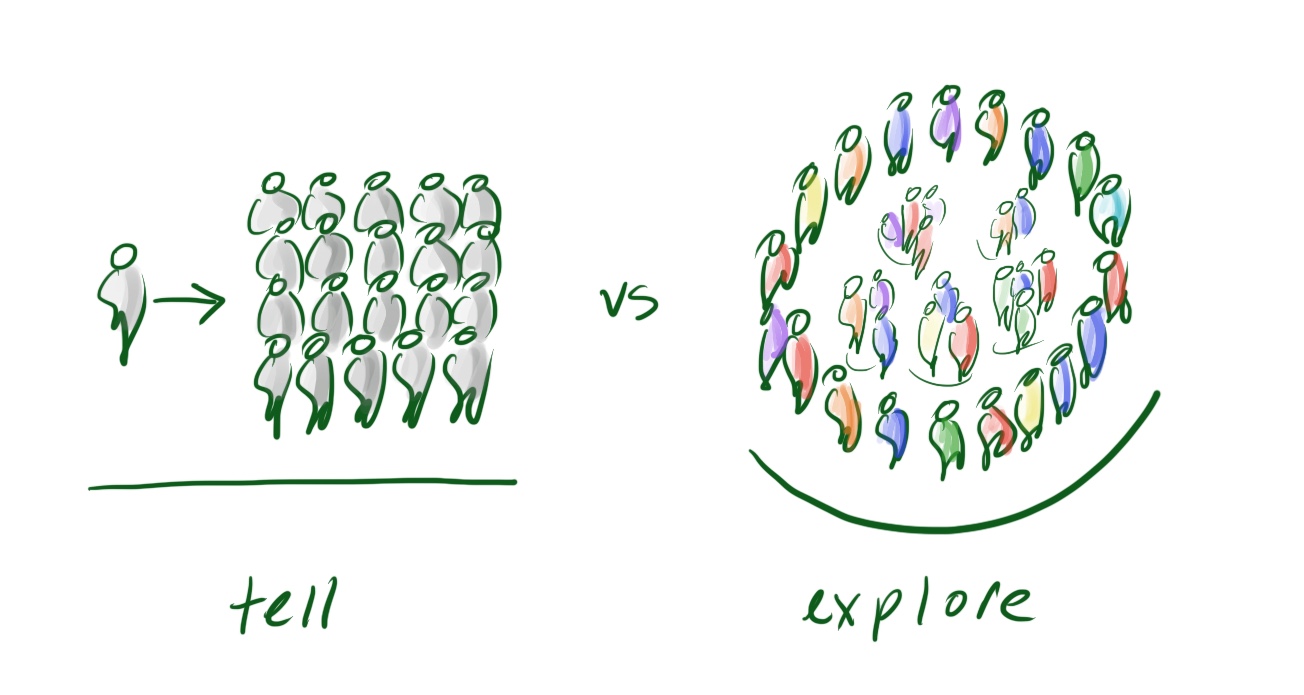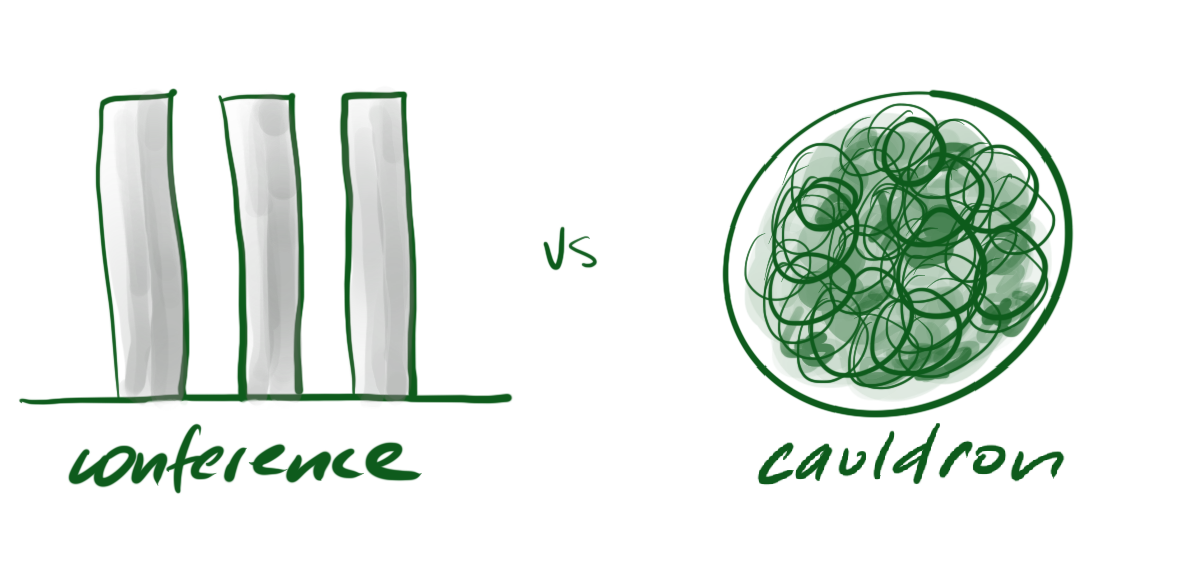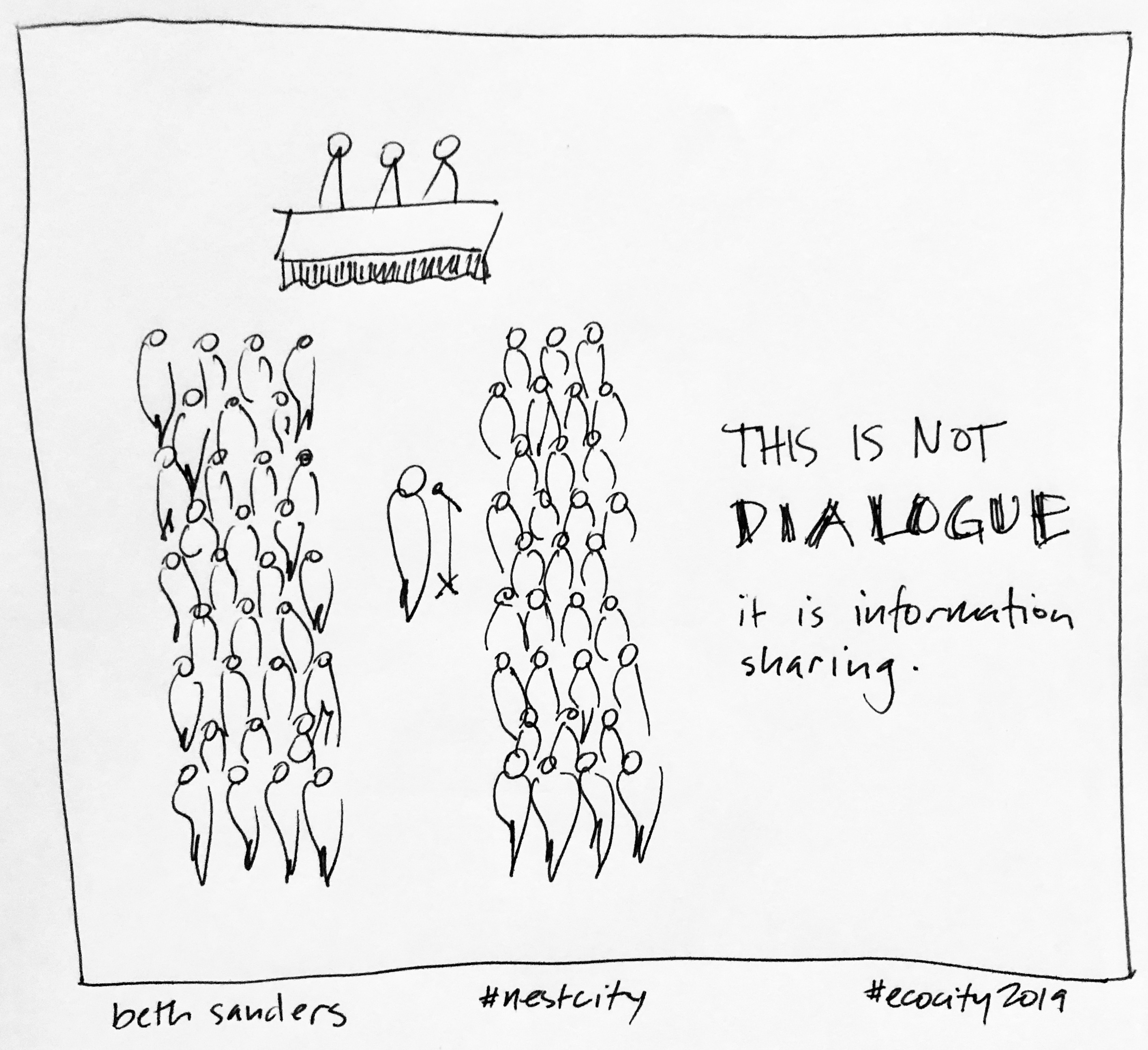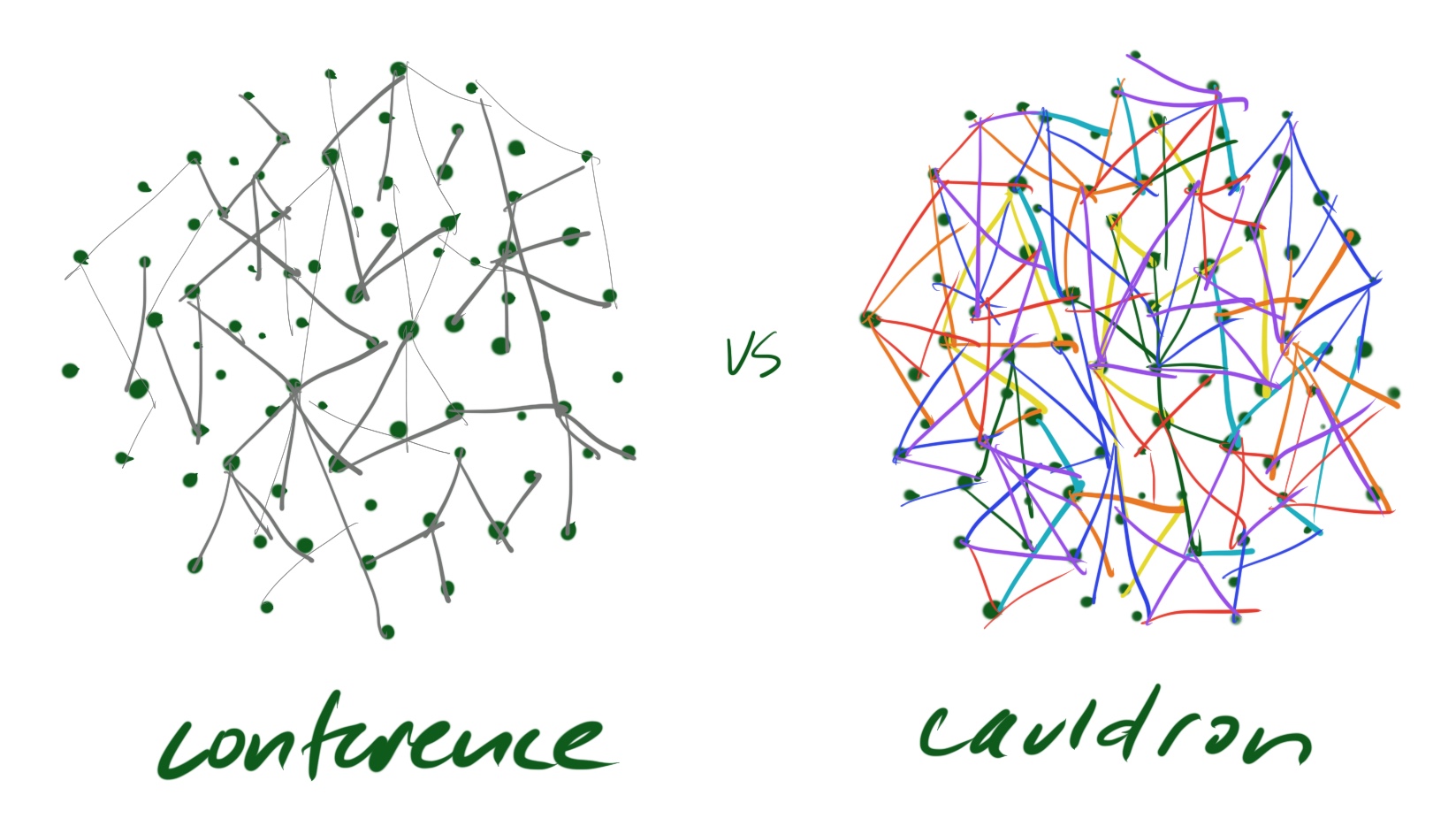At a conference where the crowd assembled believes in designing cities to mitigate and adapt to climate change, we avoided talking about the heat—the emotional heat. And avoiding emotional heat means avoiding the hard work needed to effect the changes we say we want.
I do not think this is a conscious choice, but when we organize conferences, and pour the resources we do into them, we are creating the conditions for people to tell each other about what they think about a topic. While individually, as tellers, we have explored topics at length, a conference collects the individual perspectives, puts them on display and does not allow for collective exploration. We do not notice, let alone explore, what we think; at best, we hear what a few think.
(As I write, I am conscious of a conundrum I am creating for myself. I am telling you, by writing, what I think, much the same way a lecturer does on a stage. The difference is that you are sitting reading, likely alone. You are not sitting in a room with tens or hundreds or thousands of others sitting beside you, also listening to me. You and I are not missing out on an opportunity to digest together, simultaneously, what I am exploring. And so I activate our one-on-one relationship, me the writer and you the reader. Further, rather than giving you instructions, like a (violent) saviour, I share what I notice and invite you to conduct your own exploration. Please share what you find.)
Let’s explore the contrast between telling and exploring when we gather, face-to-face, in meetings, conferences and the like, and what it means for the heat.
At conferences, when we gather physically in the same city, the same space and the same room, we keep ourselves separate. The usual format involves “the sage on the stage”, the expert and the audience. The expert tells us what we need to know, the audience receives that information. There is no or little interaction between the expert and the audience; we remain isolated from each other. Under the guise of questions and answers, we declare dialogue is taking place, but with clearly delineated roles of expert and audience, this is not dialogue. At best, it is information sharing. (NOTE: When the purpose of gathering is to share information, this format is fine.)
We pretend that by being in the same room we are networking, that the audience and experts mingle and build relationships. While this happens to a degree, it is minimal. At meals, the protocol is for the known experts sit together at the head of the room, with the people who have organized the conference and/or who are going to introduce them. We might rub shoulders at the coffee break. We accept this minimal interaction as good, sufficient.
When it comes to emotional heat, at conferences we organize ourselves to not talk about the heat we are feeling and experiencing. On rare occasions, a speaker may mention it, but we do not explore or digest it. It slips (or is shoved) to the side, remains outside of us, external. If we do notice the heat within ourselves, exploring that feeling is not expected, wanted, let alone accommodated. We sit. We listen. We network over coffee. What we could be talking about—what it will really take to move our ideas forward—is left alone. We are separate from our experience, and separate from each other.
What we could be talking about—what it will really take to move our ideas forward—is left alone. We are separate from our experience, and separate from each other.
What is compelling about conferences are the nifty people that assemble. It is fun to hear about compelling ideas and spectacular stories. It used to be that the only way to hear these folks and their ideas was at a conference, but this is no longer true. There are YouTube channels, podcasts, TED Talks, webinars. At any point, we are able to watch and/or listen to a plethora of thinkers describe what they think. Rather than sharing ideas, the conference is now about containing ideas; it doesn’t set them free, it keeps the ideas, and us, in a box. Hearing what they think no longer needs to be the purpose of face-to-face gatherings.
Rather than sharing ideas, the conference is now about containing ideas; it doesn’t set them free, it keeps the ideas, and us, in a box.
We organize conferences to control and contain what happens, by predetermining topics, themes and content, and by limiting exploratory conversation to chance at coffee breaks. We do this as a defence mechanism, to avoid experiencing the heat of conflicting views. We do this to maintain our defended positions against others. We do this to avoid being open to the influence of others. We do this to avoid having to care about others.
“The conference” keeps us in the realm of information dissemination, removed from the realm of action. Even when we say over and over that action is action we want. Ironically, what feels like talking in circles is what will lead us to wise action. What if, instead of control and containment (the conference experience), we offered a container? What if we offered a cauldron, instead of a conference?
What if, instead of control and containment (the conference experience), we offered a container? What if we offered a cauldron, instead of a conference?
Join me in a thought experiment.
“Conference”, as I am describing it here, is defined (at lexico.com) as: a formal meeting of people with a shared interest, typically one that takes place over several days. Let’s try a cauldron on for size (lexico.com) as: 1) a large metal pot with a lid and a handle used for cooking over an open fire, and 2) a situation characterized by instability and strong emotions. 
What if, when we gather to ponder wise action, we chose not to contain emotional heat and allowed it, provided a container for it?
The qualities of a conference and cauldron feel like this:
| CONFERENCE | CAULDRON | |
| Purpose | Containment, control what is talked about | Container, to support what needs to be talked about |
| Emotional heat | Contained, discouraged | Allowed, used to move toward wise action |
| What happens with conflicting ideas | Audience watches debate take place on stage and conflicting ideas are generally defended, not explored | Conversations in small and large groups explore conflicting ideas to better understand them and find a way forward |
| Our experience | One-way information sharing (with tolerance of clarification questions) | Ideas come from unexpected conversations, people with similar interests find each other |
| What it feels like |
|
|
| What we get from it |
|
|
There is good information sharing at a conference, and the connections we make with each other are valuable. A cauldron, however, can amplify the ideas and connections we make—and their meaning to us individually and collectively. This happens because how we participate shifts from passive audience to active participant.
When we passively sit in a room listening to experts, we are not listening to each other. A cauldron asks us to be in the heat as convenors, when we speak and when we participate. It asks us to expect something different of ourselves and others.
| What is asks of us | CONFERENCE | CAULDRON |
| Convenors / hosts |
|
|
| Speakers |
|
|
| Participants |
|
|
A cauldron is asking us to create the conditions to be in the heat of hearing self and other. It reminds me of the personal reflection time I need to hear myself, notice what I am feeling and experiencing, and discern the wise action that comes from a place of inner knowing. It is a place where facts and evidence rub up against my feelings, that I notice when it is time to act, or not. As groups, whatever size, we are no different–we need spaces to notice not only the actions I/we need to take, but the ones we are willing to take. The latter comes with reflection and commitment from deep knowing within, not a lecture from without.
That conference I mentioned at the top of this piece? The pinnacle was the violent saviour, the old white man with an urgent, preachy message: we must change or ways or we will die. He insisted we do as he prescribes to save ourselves. But sitting and listening for days is not going to be the answer because all we do while gathered is name actions that could be taken. We were asked to “drink from the firehose” of information about needing to take action and actions. After the conference, videos of the main speakers are shared so we can continue to feed our information addiction. An addiction that keeps us from action.
When we meet face-to-face to talk about serious stuff, and the actions that are needed, I want to have time to digest the actions asked of me. I want time for us to digest the actions we are prepared to take, to notice if we are really committed or not, or what it will take. I want to wrestle with conflicting ideas to dig into what is happening underground, the real reasons why things are happening (or not) the way they are. I want to experience a support system out there that I can call on if I need it. For wise action that sticks, we need a cauldron from time to time.
This is what I’ve come to realize: it is the emotional heat of the cauldron that enables action, not the familiarity of the conference.
This is what I’ve come to realize: it is the emotional heat of the cauldron that enables action, not the familiarity of the conference.
As always, the purpose of a gathering should guide its design. And with this, another lens into what the convenors and participants are looking for: the stability of a conference, or the danger of a cauldron. It is the latter that propels us into action.


Yes! I like where this idea is going!
What resonates with you, John?